brake light PONTIAC GRAND PRIX 2003 User Guide
[x] Cancel search | Manufacturer: PONTIAC, Model Year: 2003, Model line: GRAND PRIX, Model: PONTIAC GRAND PRIX 2003Pages: 378, PDF Size: 17.64 MB
Page 191 of 378
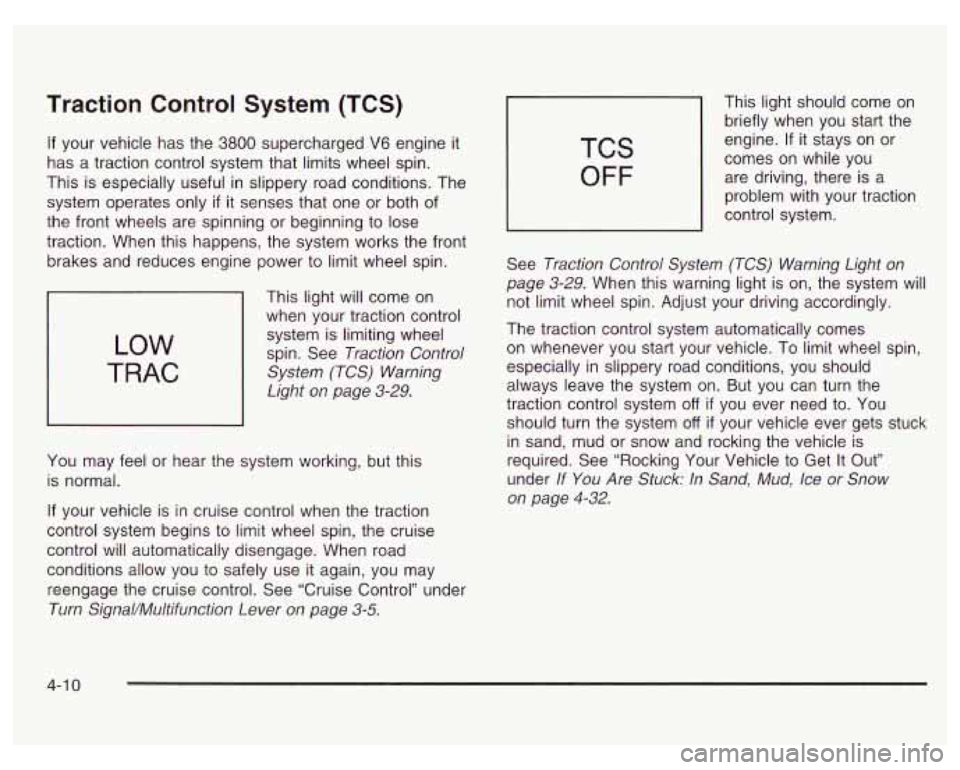
Traction Control System (TCS)
If your vehicle has the 3800 supercharged V6 engine it
has a traction control system that limits wheel spin.
This is especially useful in slippery road conditions. The
system operates only
if it senses that one or both of
the front wheels are spinning or beginning to lose
traction. When this happens, the system works the front
brakes and reduces engine power to limit wheel spin.
LOW
TRAC
This light will come on
when your traction control
system is limiting wheel
spin. See Traction Control
System (TCS) Warning
Light on page 3-29.
You may feel or hear the system working, but this
is normal.
If your vehicle is in cruise control when the traction
control system begins to limit wheel spin, the cruise
control will automatically disengage. When road
conditions allow you to safely use it again, you may
reengage the cruise control. See “Cruise Control” under
Turn SignaVMultifunction Lever on page 3-5.
TCS
OFF
This light should come on
briefly when you start the
engine.
If it stays on or
comes on while you
are driving, there is a
problem with your traction
control system.
See Traction Control System (TCS) Warning Light on
page 3-29. When this warning light
is on, the system will
not limit wheel spin. Adjust your driving accordingly.
The traction control system automatically comes
on whenever you start your vehicle.
To limit wheel spin,
especially in slippery road conditions, you should
always leave the system on. But you can turn the
traction control system
off if you ever need to. You
should turn the system
off if your vehicle ever gets stuck
in sand, mud or snow and rocking the vehicle is
required. See “Rocking Your Vehicle to Get It Out”
under
If You Are Stuck: In Sand, Mud, Ice or Snow
on page
4-32.
4-1 0
Page 192 of 378
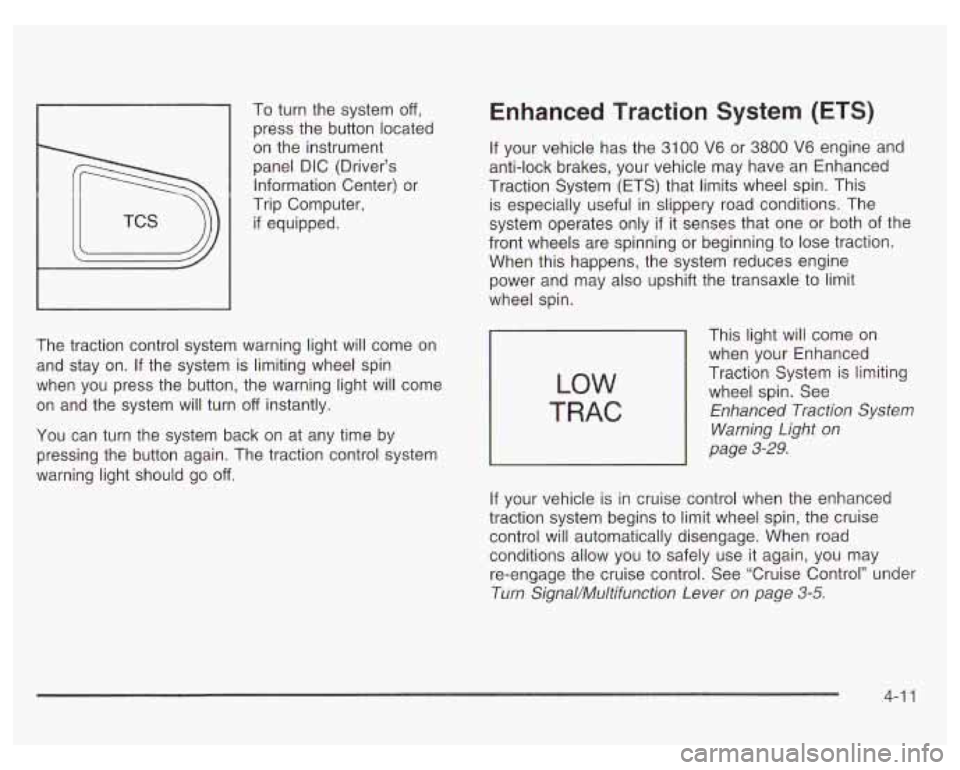
1 press the button located
To
turn the system
off,
on the instrument
panel DIC (Driver’s
Information Center) or
Trip Computer,
if equipped.
The traction control system warning light will come on
and stay on. If the system is limiting wheel spin
when you press the button, the warning light will come
on and the system will turn
off instantly.
You can turn the system back on at any time by
pressing the button again. The traction control system
warning light should go
off.
Enhanced Traction System (ETS)
If your vehicle has the 3100 V6 or 3800 V6 engine and
anti-lock brakes, your vehicle may have an Enhanced
Traction System (ETS) that limits wheel spin. This
is especially useful in slippery road conditions. The
system operates only
if it senses that one or both of the
front wheels are spinning or beginning to lose traction.
When this happens, the system reduces engine
power and may also upshift the transaxle to limit
wheel spin.
LOW
TRAC
This light will come on
when your Enhanced
Traction System is limiting
wheel spin. See
Enhanced Traction System
Warning Light
on
page 3-29.
If your vehicle is in cruise control when the enhanced
traction system begins to limit wheel spin, the cruise
control will automatically disengage. When road conditions allow you to safely use
it again, you may
re-engage the cruise control. See ‘Cruise Control’’ under
Turn Signal/Multifunction Lever
on page 3-5.
4-1 1
Page 201 of 378
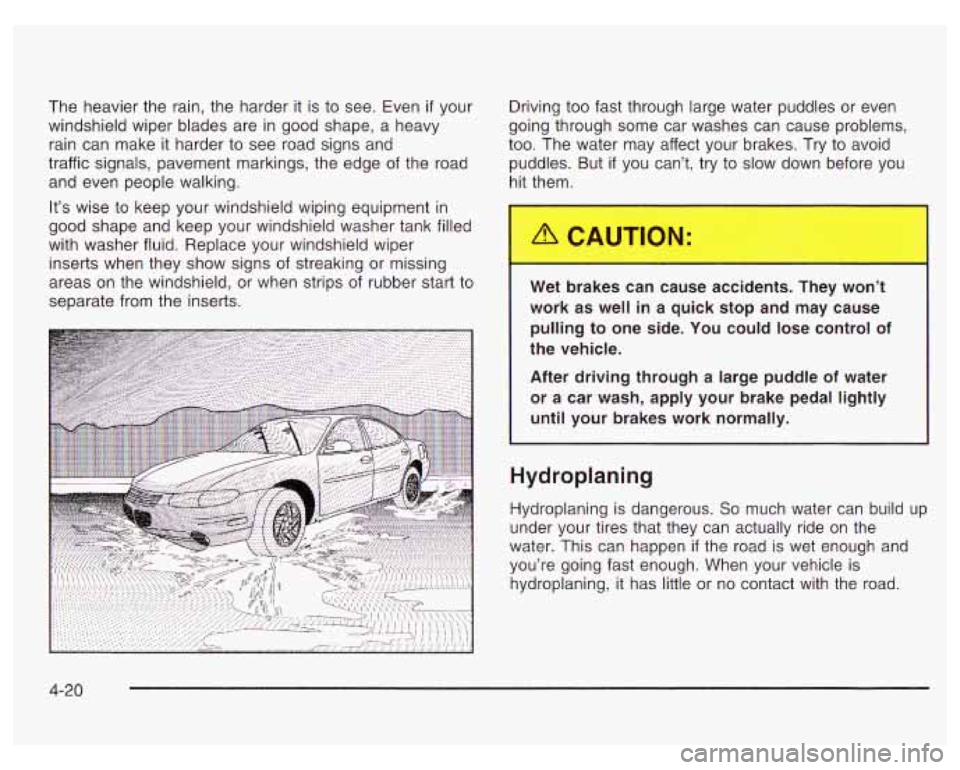
The heavier the rain, the harder it is to see. Even if your
windshield wiper blades are in good shape, a heavy
rain can make it harder to see road signs and
traffic signals, pavement markings, the edge of the road
and even people walking.
It’s wise to keep your windshield wiping equipment in
good shape and keep your windshield washer tank filled
with washer fluid. Replace your windshield wiper
inserts when they show signs
of streaking or missing
areas on the windshield, or when strips of rubber start to
separate from the inserts. Driving too fast through large
water puddles or even
going through some car washes can cause problems,
too. The water may affect your brakes. Try to avoid
puddles. But
if you can’t, try to slow down before you
hit them.
Wet brakes can cause accidents. They won’t
work as well in a quick stop and may cause
pulling to one side. You could lose control
of
the vehicle.
After driving through a large puddle of water
or a car wash, apply your brake pedal lightly
until your brakes work normally.
Hydroplaning
Hydroplaning is dangerous. So much water can build up
under your tires that they can actually ride on the
water. This can happen
if the road is wet enough and
you’re going fast enough. When your vehicle is
hydroplaning, it has little or no contact with the road.
4-20
Page 223 of 378
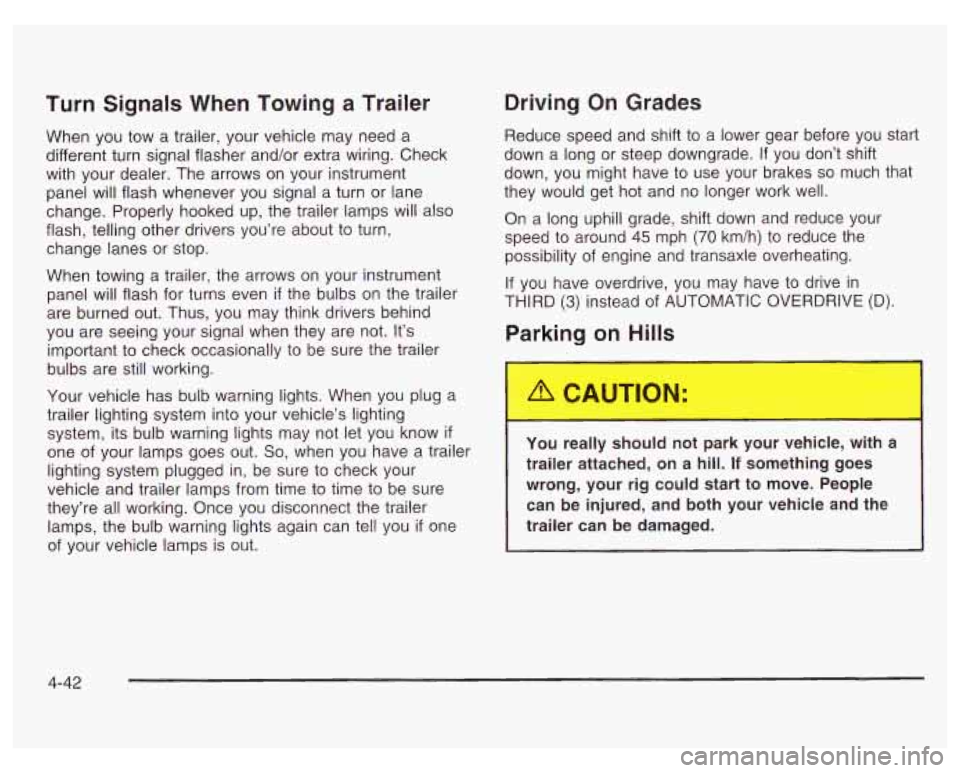
Turn Signals When Towing a Trailer
When you tow a trailer, your vehicle may need a
different turn signal flasher and/or extra wiring. Check
with your dealer. The arrows on your instrument
panel will flash whenever you signal a turn or lane
change. Properly hooked up, the trailer lamps will also
flash, telling other drivers you’re about to turn,
change lanes or stop.
When towing a trailer, the arrows on your instrument
panel will flash for turns even
if the bulbs on the trailer
are burned out. Thus, you may think drivers behind
you are seeing your signal when they are not. It’s
important to check occasionally to be sure the trailer
bulbs are still working.
Your vehicle has bulb warning lights. When you plug a
trailer lighting system into your vehicle’s lighting
system, its bulb warning lights may not let you know
if
one of your lamps goes out. So, when you have a trailer
lighting system plugged in, be sure to check your
vehicle and trailer lamps from time to time to be sure
they’re all working. Once you disconnect the trailer
lamps, the bulb warning lights again can tell you
if one
of your vehicle lamps is out.
Driving On Grades
Reduce speed and shift to a lower gear before you start
down a long or steep downgrade.
If you don’t shift
down, you might have to use your brakes
so much that
they would get hot and no longer work well.
On a long uphill grade, shift down and reduce your
speed to around
45 mph (70 km/h) to reduce the
possibility of engine and transaxle overheating.
If you have overdrive, you may have to drive in
THIRD (3) instead of AUTOMATIC OVERDRIVE (D).
Parking on Hills
1 -J really should not ,,rk yo^, wG,kle, with a
trailer attached, on a hill.
If something goes
wrong, your rig could start to move. People
can be injured, and both your vehicle and the
trailer can be damaged.
4-42
Page 275 of 378
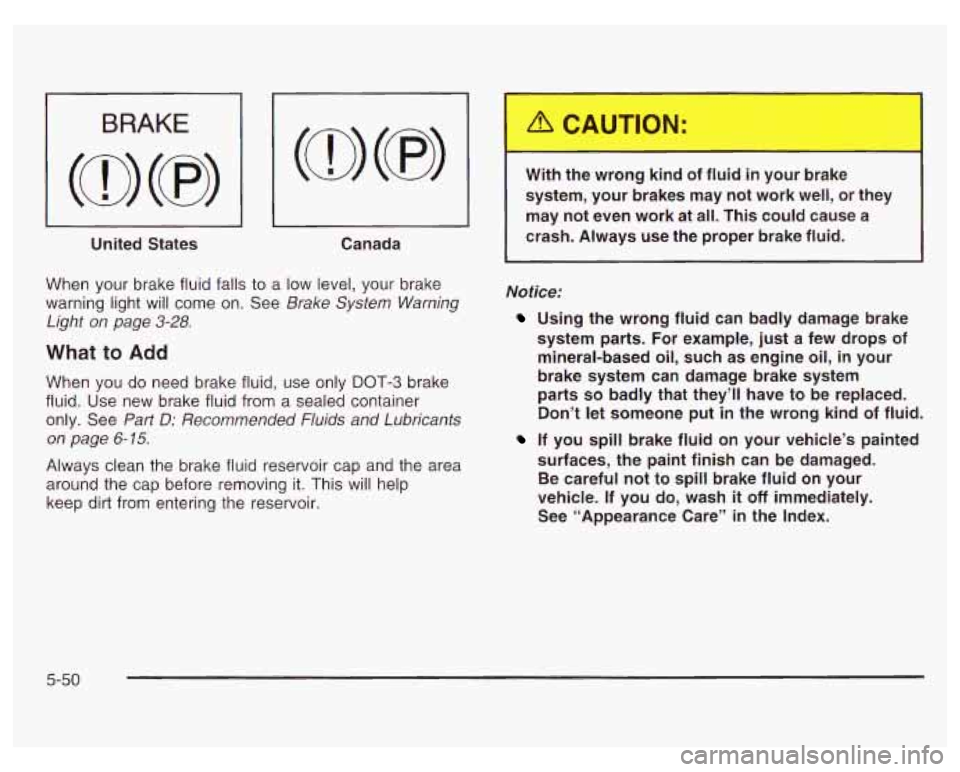
United States
~~
Canada
When your brake fluid falls to a low level, your brake
warning light will come on. See Brake System Warning
Light on page
3-28.
What to Add
When you do need brake fluid, use only DOT-3 brake
fluid. Use new brake fluid from a sealed container
only. See Part D: Recommended Fluids and Lubricants
on page
6- 15.
Always clean the brake fluid reservoir cap and the area
around the cap before removing it. This will help
keep
dirt from entering the reservoir.
r
With the wrong kind of fluid in your brake
system, your brakes may not work well, or they
may not even work at all. This could cause a
crash. Always
use the proper brake fluid.
Notice:
Using the wrong fluid can badly damage brake
system parts. For example, just a few drops of mineral-based oil, such as engine oil, in your
brake system can damage brake system
parts
so badly that they’ll have to be replaced.
Don’t let someone put in the wrong kind of fluid.
If you spill brake fluid on your vehicle’s painted
surfaces, the paint finish can be damaged.
Be careful not to spill brake fluid on your
vehicle. If you do, wash
it off immediately.
See “Appearance Care” in the Index.
5-50
Page 279 of 378
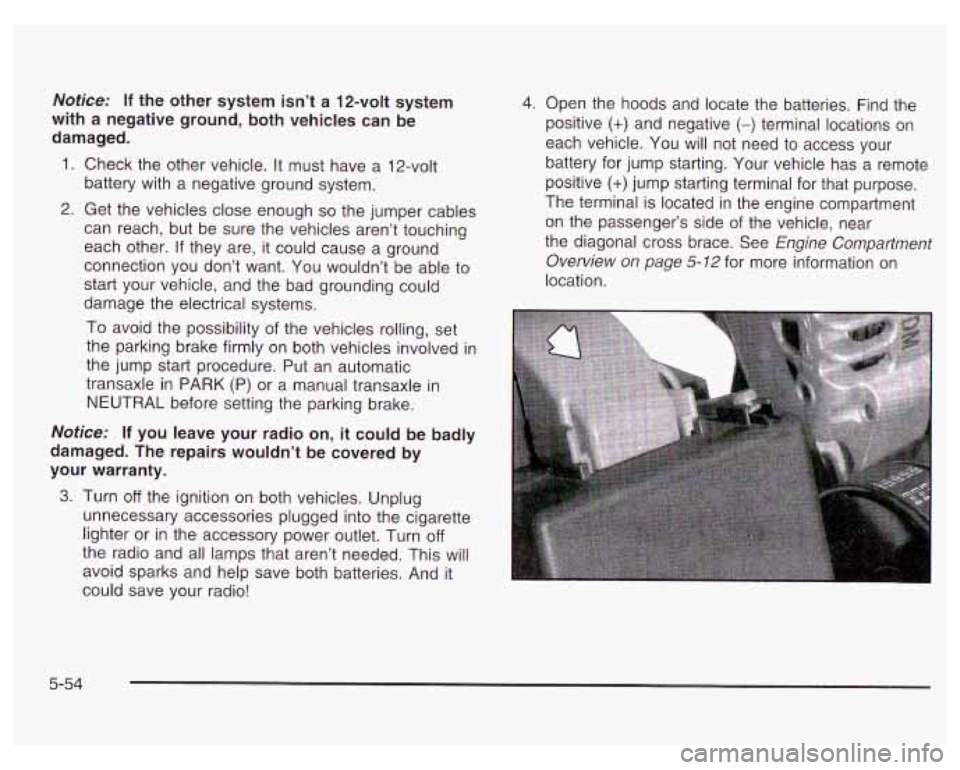
Notice: If the other system isn’t a 12-volt system
with a negative ground, both vehicles can be
damaged.
1. Check the other vehicle. It must have a 12-volt
battery with a negative ground system.
2. Get the vehicles close enough so the jumper cables
can reach, but be sure the vehicles aren’t touching
each other. If they are, it could cause a ground
connection you don’t want. You wouldn’t be able to
start your vehicle, and the bad grounding could
damage the electrical systems.
To avoid the possibility of the vehicles rolling, set
the parking brake firmly on both vehicles involved in
the jump start procedure. Put an automatic
transaxle in PARK
(P) or a manual transaxle in
NEUTRAL before setting the parking brake.
Notice: If you leave your radio on, it could be badly
damaged. The repairs wouldn’t be covered by
your warranty.
3. Turn off the ignition on both vehicles. Unplug
unnecessary accessories plugged into the cigarette
lighter or in the accessory power outlet. Turn
off
the radio and all lamps that aren’t needed. This will
avoid sparks and help save both batteries. And it
could save your radio!
4. Open the hoods and locate the batteries. Find the
positive
(+) and negative (-) terminal locations on
each vehicle. You will not need to access your
battery for jump starting. Your vehicle has
a remote
positive
(+) jump starting terminal for that purpose.
The terminal is located in the engine compartment
on the passenger’s side of the vehicle, near
the diagonal cross brace. See Engine Compartment
Ovewiew
on page 5-72 for more information on
location.
5-54
Page 334 of 378

Scheduled Maintenance
The services shown in this schedule up to 100,000 miles
(1 66
000 km) should be repeated after 100,000 miles
(1 66 000 km) at the same intervals for the life of
this vehicle. The services shown at 150,000 miles
(240
000 km) should be repeated at the same interval
after 150,000 miles
(240 000 km) for the life of this
vehicle.
See Part B: Owner Checks and Services on page
6-9
and Part C: Periodic Maintenance Inspections on
page
6- 13.
Footnotes
t The U.S. Environmental Protection Agency or the
California Air Resources Board has determined that the
failure to perform this maintenance item will not nullify
the emission warranty or limit recall liability prior to
the completion of the vehicle’s useful life. We, however,
urge that all recommended maintenance services be
performed at the indicated intervals and the
maintenance be recorded.
+A good time to check your brakes is during tire
rotation. See Brake System Inspection on page
6-14,
Engine Oil Scheduled Maintenance
Change engine oil and filter as indicated by the GM
Oil Life SystemTM (or every 12 months, whichever
occurs first). Reset the system.
Your vehicle has a computer system that lets you know
when to change the engine oil and filter. This is
based on engine revolutions and engine temperature,
and not on mileage. Based on driving conditions,
the mileage at which an oil change will be indicated can
vary considerably. For the oil life system to work
properly, you must reset the system every time the oil is
changed.
When the system has calculated that oil life has been
diminished,
it will indicate that an oil change is
necessary.
A CHANGE OIL SOON light will come on.
Change your oil as soon as possible within the next two
times you stop for fuel. It is possible that,
if you are
driving under the best conditions, the oil life system may
not indicate that an oil change is necessary for over a
year. However, your engine oil and filter must be
changed at least once a year and at this time the system
must be reset.
It is also important to check your oil
regularly and keep it at the proper level.
6-5
Page 360 of 378
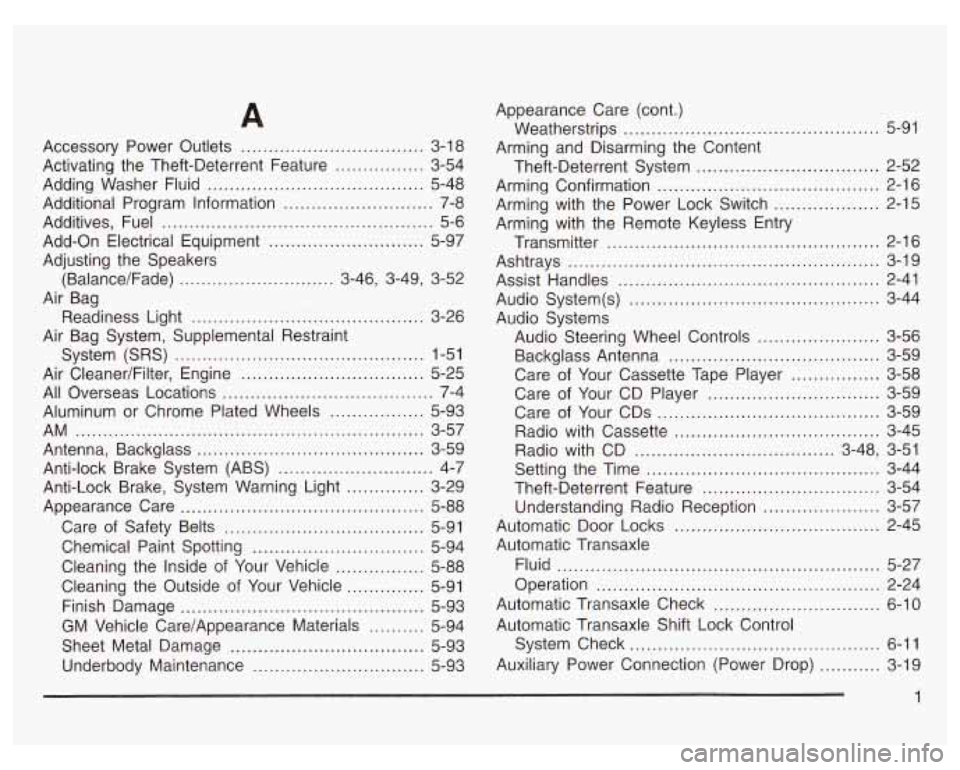
A
Accessory Power Outlets ................................. 3-1 8
Activating the Theft-Deterrent Feature
................ 3-54
Adding Washer Fluid
....................................... 5-48
Additional Program Information
........................... 7-8
Additives, Fuel
................................................. 5-6
Add-on Electrical Equipment
............................ 5-97
Adjusting the Speakers
(Balance/Fade)
............................ 3-46, 3-49, 3-52
Air Bag Readiness Light
.................................... ~ ~ ~ ~ ~ ~ ~ 3-26
Air Bag System, Supplemental Restraint
System (SRS)
............................................. 1-51
Air Cleaner/Filter, Engine
................................. 5-25
All Overseas Locations ...................................... 7-4
Aluminum or Chrome Plated Wheels
............. 5-93
Antenna, Backglass
......................................... 3-59
Anti-lock Brake System (ABS)
............................ 4-7
Anti-Lock Brake, System Warning Light
.............. 3-29
Appearance Care
............................................ 5-88
Care of Safety Belts
.................................... 5-91
Cleaning the Inside of Your Vehicle
................ 5-88
Cleaning the Outside of Your Vehicle
.............. 5-91
Finish Damage
............................................ 5-93
GM Vehicle Care/Appearance Materials
.......... 5-94
Underbody Maintenance
............................... 5-93
AM
........................................................... 3-57
Chemical Paint Spotting
............................... 5-94
Sheet Metal Damage
................................... 5-93 Appearance
Care (cont.)
Weatherstrips
.......................................... 5-91
Arming and Disarming the Content
Theft-Deterrent System
................................. 2-52
Arming Confirmation
........................................ 2-16
Arming with the Power Lock Switch
................... 2-15
Arming with the Remote Keyless Entry
Transmitter
................................................. 2-16
Ashtrays
............. ............................... 3-19
Assist Handles
.... ................................... 2-41
Audio System(s)
......................................... 3-44
Audio Systems Audio Steering Wheel Controls
...... ........ 3-56
Backglass Antenna
...................................... 3-59
Care of Your Cassette Tape Player
................ 3-58
Care of Your CD Player
............................... 3-59
Care of Your CDs
........................................ 3-59
Radio with Cassette
..................................... 3-45
Radio with CD .................................... 3-48, 3-51
Setting the Time
.......................................... 3-44
Theft-Deterrent Feature
................................ 3-54
Understanding Radio Reception
..................... 3-57
Automatic Door Locks
..................................... 2-45
Automatic Transaxle
Fluid
.......................................................... 5-27
Operation
................................................... 2-24
Automatic Transaxle Check
.............................. 6-10
Automatic Transaxle Shift Lock Control
System Check
............................................. 6-11
Auxiliary Power Connection (Power Drop)
........... 3-19
1
Page 361 of 378
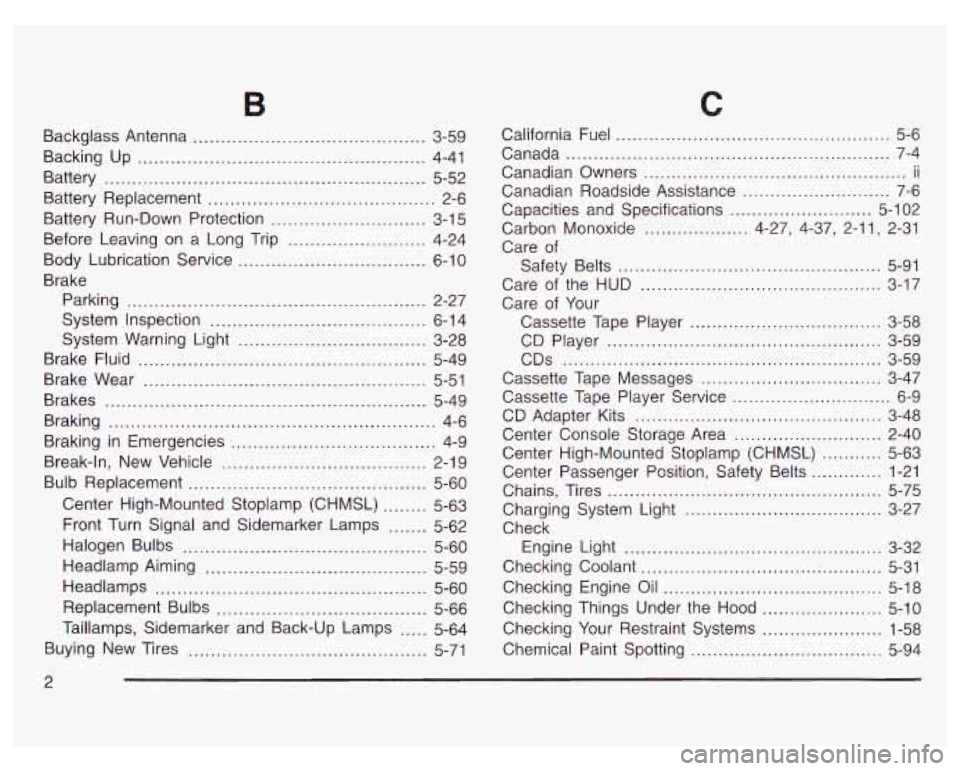
Backglass Antenna .......................................... 3-59
Backing Up .................................................... 4-41
Battery .......................................................... 5-52
Battery Replacement ......................................... 2-6
Battery Run-Down Protection ............................ 3-1 5
Before Leaving on a Long Trip ......................... 4-24
Body Lubrication Service .......................... 6-10
Brake
Parking
...................................................... 2-27
System Inspection ....................................... 6-1 4
System Warning Light .................................. 3-28
Brake Fluid .................................................... 5-49
Brake Wear ................................................... 5-51
Brakes .......................................................... 5-49
Braking ........................................................... 4-6
Break-In, New Vehicle ..................................... 2-19
Bulb Replacement ........................................... 5-60
Center High-Mounted Stoplamp (CHMSL) ........ 5-63
Front Turn Signal and Sidemarker Lamps ....... 5-62
Halogen Bulbs ............................................ 5-60
Headlamp Aiming ........................................ 5-59
Headlamps ................................................. 5-60
Replacement Bulbs ...................................... 5-66
Taillamps, Sidemarker and Back-up Lamps ..... 5-64
Buying New Tires ........................................... 5-71
Braking in Emergencies ..................................... 4-9
C
California Fuel .................................................. 5-6
Canada ........................................................... 7-4
Canadian Owners ................................................ ii
Canadian Roadside Assistance ........................... 7-6
Capacities and Specifications .......................... 5-1 02
Carbon Monoxide ................... 4-27, 4-37, 2-1 1, 2-31
Care of
Safety Belts ................................................ 5-91
Care of the HUD ............................................ 3-17
Care of Your
Cassette Tape Player
................................... 3-58
CD Player .................................................. 3-59
Cassette Tape Messages ................................. 3-47
Cassette Tape Player Service ............................. 6-9
Center Console Storage Area ........................... 2-40
Center High-Mounted Stoplamp (CHMSL) ........... 5-63
Center Passenger Position, Safety Belts ............. 1-21
Chains, Tires .................................................. 5-75
Check
Checking Coolant
............................................ 5-31
Checking Things Under the Hood ...................... 5-10
Checking Your Restraint Systems ...................... 1-58
CDS .......................................................... 3-59
CD Adapter Kits ............................................. 3-48
Charging System Light .................................... 3-27
Engine Light ............................................... 3-32
Checking Engine Oil ........................................ 5-18
Chemical Paint Spotting ................................... 5-94
2
Page 366 of 378
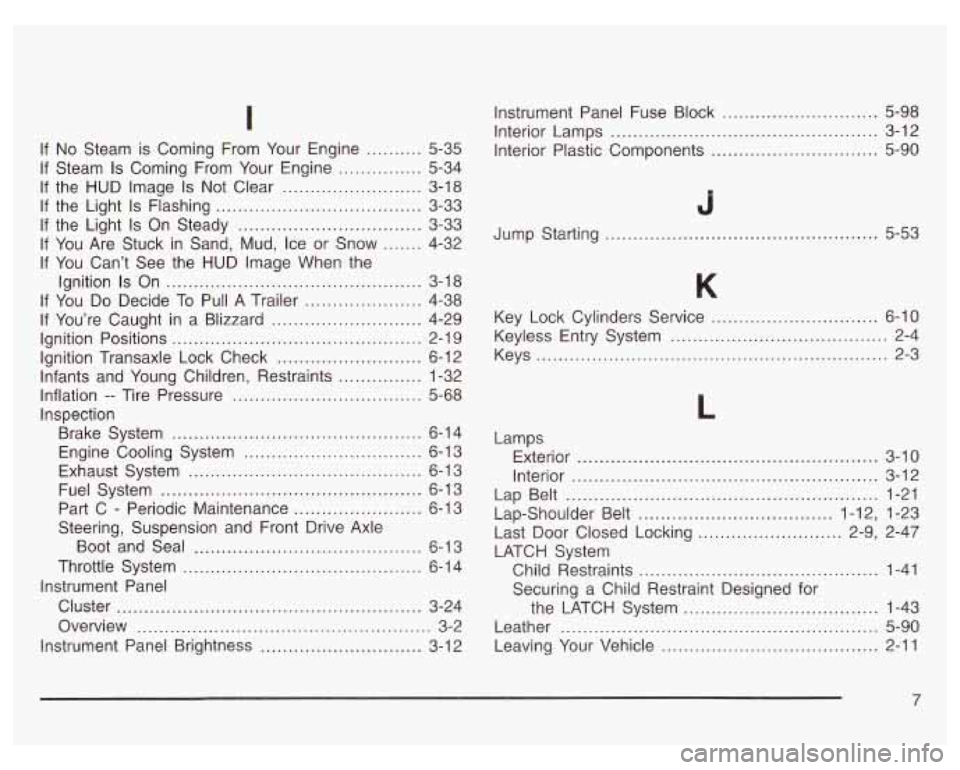
If No Steam is Coming From Your Engine .......... 5-35
If Steam
Is Coming From Your Engine ............... 5-34
If the HUD Image
Is Not Clear ......................... 3-18
If the Light
Is Flashing ..................................... 3-33
If the Light
Is On Steady ................................. 3-33
If You Are Stuck in Sand, Mud, Ice or Snow
....... 4-32
If You Can’t See the HUD Image When the
Ignition
Is On .............................................. 3-18
If You
Do Decide To Pull A Trailer ..................... 4-38
Ignition Positions
............................................. 2-1 9
Ignition Transaxle Lock Check
.......................... 6-12
Infants and Young Children, Restraints
............... 1-32
Inflation
-- Tire Pressure ............................... 5-68
Inspection Brake System
........................... ........... 6-14
Engine Cooling System
................................ 6-13
Exhaust System
.......................................... 6-13
Fuel System
............................................... 6-13
Part C
- Periodic Maintenance ....................... 6-13
Steering, Suspension and Front Drive Axle
Boot and Seal
......................................... 6-1 3
Throttle System
........................................... 6-14
Cluster
....................................................... 3-24
Overview
..................................................... 3-2
Instrument Panel Brightness
............................. 3-1 2
If
You’re Caught in a Blizzard
........................... 4-29
Instrument Panel Instrument Panel
Fuse Block
........................ 5-98
Interior Plastic Components .............................. 5-90
Interior
Lamps
................................................ 3-12
Jump Starting
................................................. 5-53
Key Lock Cylinders Service .............................. 6-10
Keyless Entry System
....................................... 2-4
Keys
............................................................... 2-3
L
Lamps Exterior
............................................... 3-10
Interior
....................................................... 3-12
Lap Belt
........................................................ 1-21
Lap-Shoulder Belt
................................... 1.12. 1-23
Last Door Closed Locking
.......................... 2.9. 2-47
LATCH System Child Restraints
........................................... 1-41
Securing a Child Restraint Designed for
the LATCH System
................................... 1-43
Leather
......................................................... 5-90
Leaving Your Vehicle
....................................... 2-11
7